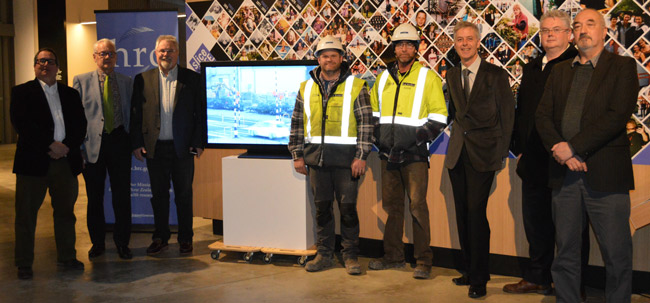
On the spot ... (from left) Department of Psychology Head of Department Professor Mike Colombo; Health Research Council Director Dr Conway Powell; Dunedin Multidisciplinary Health and Development Research Unit Director Professor Richie Poulton (Psychology); Cook Brothers Construction Site Manager Nigel Roulston and carpenter Mark Turton; Deputy Vice-Chancellor, Research and Enterprise, Professor Richard Blaikie; Property Services Strategic Architect Murray Goldfinch and Senior Project Manager Phil Chatfield..
A web camera will show the progress on a new home for University of Otago's world-renowned longitudinal Dunedin Study to people at the Slice of Life exhibition about the project, at the Toitū Otago Settlers Museum.
Cook Brothers Construction started work on the $2.6 million dollar building for the Dunedin Multidisciplinary Health and Development Study more than a fortnight ago and should be finished by the end of the year.
Footage of the construction will start playing on a screen in the Slice of Life exhibition in about two months, once ultrafast Internet links are in place.
Linking the exhibition and the building site on the corner of Union Street and Anzac Avenue by webcam was the brainchild of Study Cohort and Assessment Manager Sean Hogan, so the people of Dunedin and Study members can watch the Study's new home being built.
Study members outside Dunedin will be able to keep track of progress on the Dunedin Study's website, which will also stream the feed.

Research in action ... at the Dunedin Multidisciplinary Health and Development Study.
The Study has been examining every aspect of the health, development and well-being of more than 1000 Study members born in Dunedin in 1972 and 1973.
Cook Brothers Construction Site Manager Nigel Roulston says the concrete has already been laid for the base of the building's lift, and three-quarters of the perimeter boxing has been completed.
The concrete slab foundation will probably be laid in about a fortnight, weather permitting. Although the frosts have not been a problem, rain would be.
While some staff are working on-site others have been assembling the timber framing off-site, so it will go up relatively quickly to meet the tight time-frame, he says.
In the early days, the Study was based in Knox Church Halls, then shifted temporarily to the Barningham Building — behind the School of Dentistry — where it ended up staying for 30 years.
The Study had to move in November last year because the building was being demolished for dental school developments. Now it is in the Logan Park Annexe, which also houses Otago Cricket, in Logan Park Drive.
The new site previously housed the University of Otago College of Education Hard Technology Block.
The Dunedin Study brings Study members back at regular intervals in their lives for a day of intensive interviews and testing, which cover every aspect of their lives and wellbeing, from mental health to cardiac fitness and respiratory tests.
"We could probably fund twice as many research projects and programmes every year if we had the funds … (but) the cream rises to the top."
For more than 40 years the Health Research Council (HRC), and its predecessor the Medical Research Council, has been a key funder of the Study. Council director and Otago alumnus Dr Conway Powell says, as an example, HRC's funding support has included over $19 million since 2003.
That is a "huge amount" given the funding the council gives out annually to projects and programmes across New Zealand has usually been about $65 million in total (although more than $105 million in 2016), in a highly competitive funding arena.
“We could probably fund twice as many research projects and programmes every year if we had the funds … (but) the cream rises to the top,” Mr Powell says.
The HRC probably did not realise how globally renowned the study would become when it started funding the project but “it's like a lot of things, you start off with a genesis of an idea and if all the support is there from both the University and HRC as the major funder to back up excellent research, then they have the opportunity to grow … they become even more outstanding.”